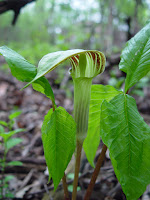A pair of Tree Swallows Tachycineta bicolor are nesting in one of several nest boxes near the wild wild woods. Today she laid the third egg. She is not yet incubating them, but keeps guard at the box opening all day.
5/23/2016
5/22/2016
feeding baby birds
5/21/2016
furnishing a nestbox: House Wren
A House Wren Troglodytes aedon carries twigs, one at a time, to a nest box.
The male works until he fills the box with twigs, leaving a small cup or cavity.
The female adds soft grasses, fur, feathers, and junk to line the cup where she will lay her eggs.
Below, we peek inside another nest box containing a cozy nest for seven wren eggs.
The female will incubate the eggs for about 2 weeks.
5/20/2016
woods in bloom
top left: Arisaema triphyllum Jack-in-the-Pulpit; top middle: Geranium maculatum Wild Geranium; top right: Asarum canadense Wild Ginger; and a view of Aquilegia Columbine, all blooming now in the wild wild woods.
5/15/2016
nest cavity
A pair of Downy Woodpeckers decided the tree stump near the feeder garden is a good prospect for their 2016 nest cavity. They've been excavating into the old tree for a few weeks. Today, the female peeked out long enough for a look around; it was long enough for us to get a look at her!
5/14/2016
new hatchlings
Seven little Black-capped Chickadee eggs hatched in the last few days. The nestbox cam caught a snapshot when they were all gaping for food.
5/09/2016
Subscribe to:
Comments (Atom)










